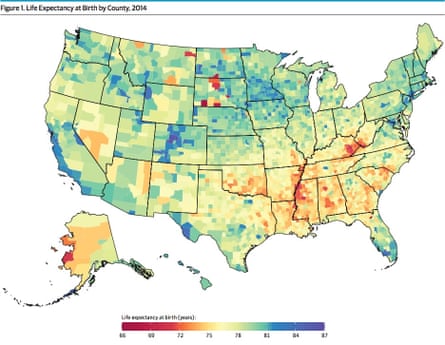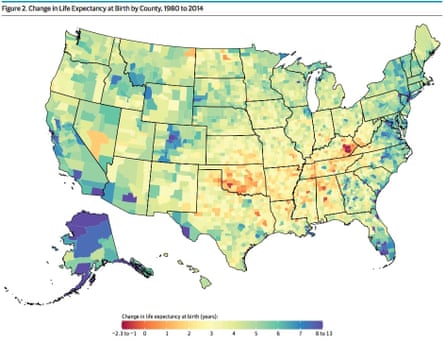Your average life expectancy now varies by more than 20 years depending on where you live in the United States, according to an in-depth study by the University of Washington.
America’s “life expectancy gap” is also predicted to grow even wider in future, with 11.5% of US counties having experienced an increase in the risk of death for residents aged 25–45 over the period studied (1980-2014). No previous study has put the disparity at even close to 20 years.
“This is way worse than any of us had assumed,” said Ali Mokdad, professor of global health at the University of Washington’s Institute for Health Metrics and Evaluation and one of the authors of the study, published by the journal JAMA Internal Medicine.
The researchers found that while residents of certain affluent counties in central Colorado had the highest life expectancy at 87 years, people in several counties of North and South Dakota, typically those with Native American reservations, could expect to die far younger, at only 66.
“The magnitude of these disparities demands action, all the more urgently because inequalities will only increase further if recent trends are allowed to continue uncontested,” the report states.
Overall, the study puts average life expectancy in the US at 79.1 years, an increase of 5.3 years from 1980 – the start of a 35-year period for which the university team compared death records, census returns, the human mortality database and figures from the National Center for Health Statistics on a county-by-county basis. But it concludes that this 5.3-year increase “masks massive variation at the county level”.
“Counties in central Colorado, Alaska and along both coasts experienced much larger increases, while some southern counties in states stretching from Oklahoma to West Virginia saw little, if any, improvement over this same period,” the report says.
“Similarly, there was considerable variation among counties in the percent decline in the mortality risk within each age group. While all counties experienced declines in mortality risk for children 0 to five years, and nearly all experienced declines in the mortality risk for adolescents and older adults 45 to 85, 11.5% [of counties] experienced increases in the risk of death between ages 25 and 45 years.”

If the figures are surprising, the factors cited in the study to explain the “large and increasing” geographic inequalities perhaps are not. The authors point the finger at differences in socioeconomic and race/ethnicity factors, the availability of – and access to – quality healthcare and insurance, and “preventable risk factors” such as smoking, drinking and physical inactivity.
“You expect disparities in any country, but you don’t expect the disparities to be increasing in a country with our wealth and might,” Mokdad said. “We spend more money on healthcare than anybody else, and we debate the hell out of healthcare more than anybody else, and still the disparities are increasing.
“Everybody, in Europe and elsewhere, is increasing life expectancy at a greater pace than we are, so that’s also disappointing and not acceptable for a country like the US.
“Compare us to Australia – a young country, lots of immigrants, a native population – and they have been more aggressive than us in many of the laws for prevention. On gun control, on drinking and driving, they’re ahead of us. On tobacco – their packaging on tobacco, their advertisements – we’re not even close to them right now.”
Analysis of county-by-county statistics allowed the study team to identify the areas of greatest inequality and incorporate their findings into a colour-coded map of the US, where counties in which life expectancy at birth is low are shaded in red, and those with longer expectations are blue.
As well as the pockets in the Dakotas, swaths of dark red are particularly prevalent in rural western Mississippi, eastern Kentucky and southwestern West Virginia – areas that are all considered to be generally economically challenged.
Meanwhile, the darkest blue covers most of central Colorado, western Wyoming and Texas, the majority of the coastal counties of California and southwestern Florida, with a concentration also seen in southern Minnesota.

According to Mokdad, the ongoing wrangling in the US Congress over health insurance reform perfectly showcases one of the factors cited for the inequality. “Many people don’t have health insurance, but even among those who do it’s misleading,” he said.
“My insurance, for example, allows me to go to a doctor for an exam and a blood test and they’ll tell me if I have a problem early on. Many don’t have that luxury, only catastrophic insurance, so if they’re hit by a car they’ll be treated.
“There are disparities by race, by economy, by geography. In Seattle there’s a good medical centre but if I have a heart attack and I’m two hours away in the mountains, it’s going to take me longer to get good care.
“If you decide to eat right it’s so expensive. We’re one of the richest cities in the country – we have Amazon, Boeing, Microsoft, headquartered here among many other companies – but if you go into some stores here in the poor areas south of the city, you can’t buy fresh fruit, vegetables and salads.
“We have places where there’s an obesity epidemic, and we have an epidemic of smoking that’s coming down but still as high in some rural areas as Europe and the Middle East.”
Previous studies recorded lower variations ranging from 12 to 17 years between counties, with the highest and lowest life expectancies in both 2007 and 2010. These were an underestimation, according to the University of Washington team, because data from smaller counties was either combined with others or excluded altogether.
Mokdad said he was looking for the report to start a conversation between communities, healthcare experts and policymakers about narrowing the inequality gap.
“In the US, do we want to wait for people to come to the hospital so we can treat them? That’s a failure,” he said. “We need to make an investment in prevention.
“People who are sick need the best treatment, we all agree, but that investment shouldn’t be at the expense of what is really important: planning the health of a nation and prevention of disease. I’m hoping the policymakers will look at this and say whatever we are doing is not about politics any more, it’s about the future of the United States.”
Over the coming year, the Guardian’s Inequality Project will shed new light on issues of inequality and social unfairness around the world. Read all of our coverage here. To get in touch, email us at inequality.project@theguardian.com.

Comments (…)
Sign in or create your Guardian account to join the discussion